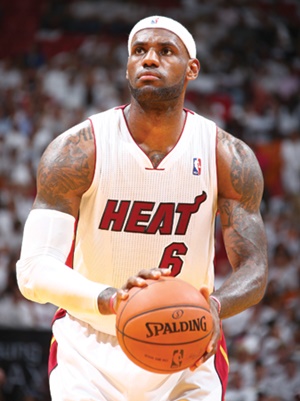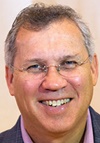NBA players may be willing to raise the age limit for players by one year, but only if there is also a mechanism that would allow new high school graduates who are deemed NBA-ready to be drafted,
National Basketball Players Association acting Executive Director
Ron Klempner said.
Eliminating the so-called one-and-done rule, which allows players to be drafted into the NBA after one year of college, is a priority for new NBA Commissioner
Adam Silver, and it was a topic of discussion at the annual Sports Lawyers Association conference in Chicago earlier this month.
Responding to a question, Klempner said there was a “strong possibility” that the union could agree to a change in the rule, but only if it went “both ways.”
In a follow-up interview, Klempner said players were not willing to raise the age limit to 20 or two years out of high school from the current one year out of high school without also giving younger players who were ready a chance to play in the NBA.
“This is not a new issue,” he said, adding that it was a concept that the players and owners discussed during the 2011 lockout that led to the current NBA collective-bargaining agreement.
 |
|
The idea would be to allow some NBA-ready players to enter the league from high school, as LeBron James did.
Photo by: NBAE / GETTY IMAGES
|
The way it would work, under the players’ proposal, which was discussed but never seriously bargained over, is high school graduates would have a chance to declare for the NBA. If they didn’t take that option, they would then have a two-year commitment to play basketball in college or elsewhere.
Klempner declined to reveal details about the plan, including how it would be determined which players could enter the draft. He said it would likely require changes in NCAA rules.
The current age limit of 19 or one year out of high school was something that the NBPA fought but reluctantly agreed to in the 2005 CBA. Klempner noted successful players, including Kobe Bryant and LeBron James, who were drafted out of high school before the rule went into effect.
Daniel Rube, NBA senior vice president and deputy general counsel, said that the league wants to raise the age limit for a number of reasons, including that it would give clubs time to better evaluate talent and to make more informed choices on which players to draft.
“Some say more experience doesn’t make a difference,” Rube said. “We think it will make a difference, and we think it will lead to better decision making.”
Asked during a question-and-answer session whether the owners were willing to offer something in exchange for raising the age limit, Rube said, “We don’t view it as that kind of issue.”
 |
Klempner
|
 |
Rube
|
But the players have long resisted increasing the age limit for economic reasons, namely that it shortens their NBA careers and their lifetime earning capacity.
“As it is, there is a small window for NBA players to earn their living, and we’re not interested in making it any smaller,” Klempner said. “If we force a capable 19-year-old player to wait another year before he can start working and earning in the NBA, we can’t give that year back to him when he’s 35. That being said, if the league is willing to agree that capable players can start earning in the NBA a year earlier when they’re 18, we could have a discussion about whether players who decide to go to college should do so for two years and not one.”
Rube, asked about why players would agree to a higher age limit when they have historically resisted this, said in a follow-up email: “It’s not a league vs. union issue. Better positioning teams and players to succeed is good for everyone.”
Both Rube and Klempner said that the league and the union have discussed the issue since the NBA CBA was agreed upon in 2011. Klempner said the union expects to continue those discussions after it names a new executive director.
> HUNDREDS OF CANDIDATES REVIEWED FOR NBPA SEARCH: The NBPA is expected make that selection, filling a position that has been vacant since player representatives fired Billy Hunter in 2013 after an internal union report found that Hunter acted in his own interests and against the interests of players. Klempner provided an update of the search, saying that Reilly Partners, the search firm that was hired to fill the position, had contacted about 250 candidates for the job. Of those, NBPA player leaders interviewed “about 50 serious candidates.”
A number of candidate names have surfaced in the media, but Klempner said he would not reveal names, noting that many of these candidates have other jobs.
Klempner noted that people have wondered why the search for Hunter’s replacement is taking more than a year to complete. “The truth is that more important than getting the search done is getting the search done properly,” Klempner said. “This is a collective decision; it has to be made not just by our executive committee, but our 30 player reps.”
> NO PLAYER TIMELINE FOR STERLING SALE: Klempner also said there is no timeline for the sale of the Los Angeles Clippers by owner Donald Sterling.
At a news conference after the NBA’s Silver announced that he had banned Sterling for life for making racist comments, the NBPA’s first vice president, Roger Mason Jr., said players wanted a timetable for the sale of the team by Sterling.
But Klempner noted that at the time Mason made the comments, players were hearing all kinds of rumors and reports that Sterling might receive a fine and a one-year suspension. Silver more than met the players’ expectations by imposing the maximum fine of $2.5 million, as well as a lifetime ban, and undertaking subsequent moves to force Sterling to sell the team.
 |
Clark
|
Tony Clark, the new MLB Players Association executive director, said that baseball players watched carefully and applauded the way that the NBPA and NBA players handled the Sterling situation.
“As one of the most diverse unions at the table, racism, prejudice and those types of things are obviously not worthy of much discussion, beyond the fact that we appreciate the fact that in the midst of the chaos, it gave them the opportunity to bring people together,” Clark said.
“It was refreshing to see players come together and understand what their organization was trying to do and voice their opinions being on the right side of the fence, collectively.”
Rube did not take any questions at the Sports Lawyers Association meeting on Sterling, as it is anticipated to be a legal matter.
> NHL CAP EXPECTED AROUND $70 MILLION: NHL Deputy Commissioner Bill Daly said he expects the salary cap for the 2014-15 season to be near $70 million, close to its level before the 2012-13 lockout.
The new NHL CBA, which ended the lockout in January 2013, reduced the players’ share of revenue from 57 percent to 50 percent. NHL clubs and players operated under a $64.3 million cap this season.
The highest salary cap since the cap was instituted in the 2005 NHL CBA was $70.2 million. The reason the cap is going up so fast is that NHL revenue grew significantly, Daly said, although he did not reveal revenue numbers.
NHL Players’ Association Executive Director Don Fehr, meanwhile, said he expects lockouts to continue in the team sports with salary caps in place. “It follows a pattern in which the owners feel they have nothing to lose by locking out the players in the salary cap sports, and therefore, let’s have a lockout as a matter of routine. … I haven’t seen anything that makes me think that is going to change.”
> R-E-S-P-E-C-T: The NFL is focused on implementing several measures to ensure fair and professional conduct in the workplace, in light of recent controversies that include the treatment of reporters and the alleged harassment of 49ers offensive tackle Jonathan Martin when he played for the Miami Dolphins.
Adolpho Birch III, NFL senior vice president of labor policy and government affairs, talked about the focus but did not reveal details of the measures.
“In consultation with a number of experts, we have implemented a number of things that we think will have a significant impact. It all adds up to one simple point, and that is what we regard as ‘respect at work,’” Birch said.
Birch said the NFL intends to become a leader in cultural and workplace respect. That means “respect for your colleagues, respect for your teammates, respect for your game opponent, respect for the officials, respect for the clubs and the staff. Respect for your coaches, respect for everyone at that game during that game.”
Liz Mullen can be reached at lmullen@sportsbusinessjournal.com. Follow her on Twitter @SBJLizMullen.









